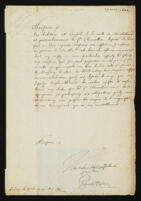Leaf from a copy of Aristotle, Categoriae in Latin translation by Boethius with fragment of Themistius, De decem categoriis. Label on what was once spine of cover, 'Epis[tol]a Sacra'; 'N29' in what appears to be the same ink; '85' in another ink. 8 small slits made around former spine for the purpose of fastening.
Reports that he has written to Sidgwick's brother [Arthur?], and expresses the hope that he 'may be able to meet his wishes.' Claims to be ashamed of himself for not writing to Sidgwick as he promised to do, 'about Baudeau, Letr[ .], [ ].' Explains that his failure to do so 'was due to absolute incapacity.' Claims that '[his Life of Richard Cobden?]...is a narrative and a biography...and not a treatise.' Expresses the wish that Sidgwick would write an article on George Eliot for the Fortnightly Review.
Morley, John (1838-1923), 1st Viscount Morley of Blackburn, politicianIncomplete.
Images of St Peter (item 4), St John the Baptist (item 5), St Philip (item 6), St Bartholomew (item 7), St Judas Thaddeus (item 8), and St Andrew (item 9).
Leyden, Lucas van (1494-1533), Dutch painter and printmakerAttributed to Georges Reverdy and to Giulio Bonasone
Reverdy, Georges (fl 1529-1564), printmakerSee the separate descriptions of the contents. On the spine is stamped ‘Marquiss [sic] of Winchester’.
Paulet, William (? 1474/5-1572), 1st Marquess of Winchester, administrator and noblemanSigned by W[illiam Cecil, Lord] Burghley; E[dward Fiennes de Clinton, Earl of] Lincoln; T[homas Radcliffe, 3rd Earl of] Sussex; F[rancis Russell, 2nd Earl of] Bedford; F[rancis] Knollys; Fra[ncis] Walsingham.
With engraving of Walsingham by J. Cochran, published by Harding & Lepard, Pall Mall East, Jun. 1829.
Accompanied by a transcript.
Poem starting "One faire par-royall, hath our [is]land bred", with "R.C. 1596" at bottom, accompanied by a later transcript starting "One fair pair-royal hath our island bred / Whereof one is alive and two are dead - / Sydney the prince of prose and sweet conceit, Spenser of number and heroic rhyme - / ... Camden thou livst alone of all the three ...."
Cotton, Sir Robert Bruce (1571–1631) 1st baronet, antiquary and politicianA copy of the beginning of the Textus Roffensis, with the Law of Æthelberht, the Law of Hlothhere and Eadric, the Law of Wihtred, and lists of Kings (West-Saxon genealogy) from Cerdic to Æthelred, with the descent of Cerdic from Woden. With some underlining in orange-red chalk.
UnidentifiedThis engraving appeared in Francis Bacon’s Historie of the Raigne of King Henry the Seventh (London: Printed by W. Stansby for Matthew Lownes, and William Barret, 1622).
Payne, John (1607-1647), engraverAccompanied by folded sheet enclosure with MS biographical note on Bernard.
Macaulay, Thomas Babington (1800-1859), 1st Baron Macaulay, historian, essayist, and poetWith a letter from P. [O'Callaghan?] to Cordelia Whewell dated 19 Apr. 1852, with a transcription of the document.
An unsigned letter addressed to "Loving Cousen," two pages closely written, with several phrases crossed through and additions made both interlinearly and via an insertion symbol at the bottom. A note in a later hand appears at the top of the first page: "This was wrote to his nephew afterwards Dr Isaac Barrow M[aste]r of Trinity. See his life concerning the engagement."
The writer is a royalist and refers to a small allowance he gives to the recipient, and reacts strongly to the news that the recipient was been offered a fellowship by "Regi-cides", and mentions both Dr Hill and Dr Comber (the present and the ejected Masters of Trinity). The writer deplores the fact that he had heard of the fellowship after the fact and argues that "as themselves are counterfeit so are all their actions but personations, and perforce I cannot thinke you any more actually fellow than if you had taken to you a company of souldiers and by violence and force taken possession of what you now owne, neither can they claime their places by any other then a military title, as one of them was not ashamed to tell me." The writer urges Barrow to forsake the false title, and states that if Barrow thinks of applying himself to Dr Comber that he will endeavour to facilitate this through his connections.
On the spine is stamped ‘Documens de Charlotte de Beaune’.
Descartes, 'Recueil du Calcul qui sert à la géometrie'; Sluse, 'De Inventione mediarum inter externas datas'; 'Anderso: Secti: Ang: Theor: 9 et Problena No. 1' [i.e., extract from Anderson's 1615 edition of Viète, Ad Angularum Sectionem Analytica Theoremata F. Vieta].
'Hoc scripsi Anno Dom[ini] 1650 R. T. [followed by a flourish]' written on the front cover; 'ὅσον τό xένον [sic]' added, perhaps in a different hand. Note on inside front cover, 'Ce Tretté est de M[onsieu]r René Descartes'; below, in another hand, 'To M[istr]ess Mildmay at Amersden in Oxfordshire for Mr Ash', with instructions for carriage from London. Note on inside back cover, 'Posteriorum ipsimet transcripsi en [?]originalis Auctorisamici mei amantissimi Renati Francisci Slusii. [Word lost at end]'. Pen scribbles, algebraic notes and 'fiat voluntas' in pen on back cover.

![Letter from Oliver Cromwell to the Master of Trinity [Thomas Hill]](/uploads/r/trinity-college-library/6/5/3/653a761be359523ffef4bcee5241302461ab17ac75cde8d8bcff527f00b29dac/O.11a.1.3_thumb.jpg)